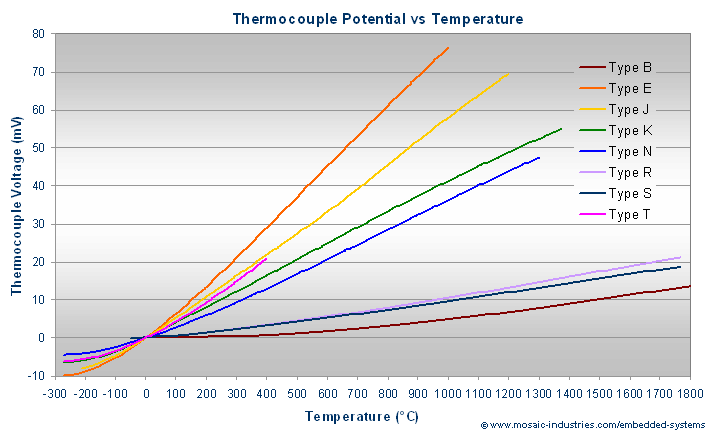Thermocouple Types
A thermocouple is a temperature sensor that uses a junction formed by dissimilar metals. It is simply a pair of wires of different composition, joined at one end. The thermocouple produces a small voltage, also called the thermocouple potential, roughly proportional to temperature. The thermocouple potential is produced in part by a junction effect, but mostly by the influence of a temperature gradient on each wire, called the Peltier and Seebeck effects. Unless otherwise indicated, all standard thermocouple models and tables show voltages referenced to a cold junction at zero degrees Centigrade, 0 °C. For an overview of thermocouple types and their uses we recommend the Wikipedia article on thermocouples.
For using a thermocouple to measure temperature with a Mosaic controller, use Mosaic's Thermocouple Wildcard.
Types of thermocouples
There are several common types of thermocouple available, each with a characteristic sensitivity and optimal temperature measurement range. The following graph shows the thermocouple voltage produced by each as a function of temperature (assuming a cold junction at 0 °C).

As you can see, most thermocouples become less sensitive (that is, the slope of the graph is less) at lower temperatures. For each of these thermocouple types, the following table summarizes their composition (for the + and – leads), sensitivity, and approximate useful temperature range.
| Thermocouple Types | |||
|---|---|---|---|
| Type | Composition | Sensitivity | Temperature range |
| Type B | (+) Platinum - 30% Rhodium (–) Platinum - 6% Rhodium | 5 to 10 µV/°C | +250 to +1820 °C |
| Type E | (+) Chromel (Ni-Cr) (–) Constantan (Cu-Ni) | 40 to 80 µV/°C | –270 to +1000 °C |
| Type J | (+) Iron (–) Constantan (Cu-Ni) | 50 to 60 µV/°C | –210 to +1200 °C |
| Type K | (+) Chromel (Ni-Cr) (–) Alumel (Ni-Al) | 28 to 42 µV/°C | –250 to +1250 °C |
| Type N | (+) Nicrosil (Ni-Cr-Si) (–) Nisil (Ni-Si-Mg) | 24 to 38 µV/°C | –250 to +1300 °C |
| Type R | (+) Platinum (–) Platinum - 13% Rhodium | 8 to 14 µV/°C | –50 to +1768 °C |
| Type S | (+) Platinum (–) Platinum - 10% Rhodium | 8 to 12 µV/°C | –50 to +1768 °C |
| Type T | (+) Copper (–) Constantan (Cu-Ni) | 17 to 58 µV/°C | –250 to +400 °C |
See also → Measuring Temperature
